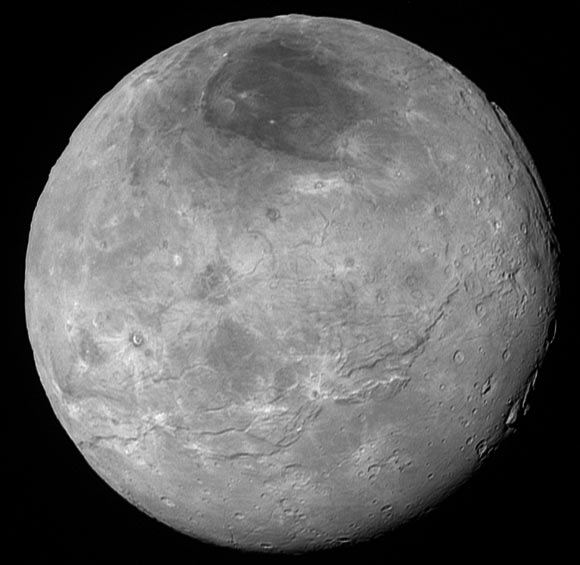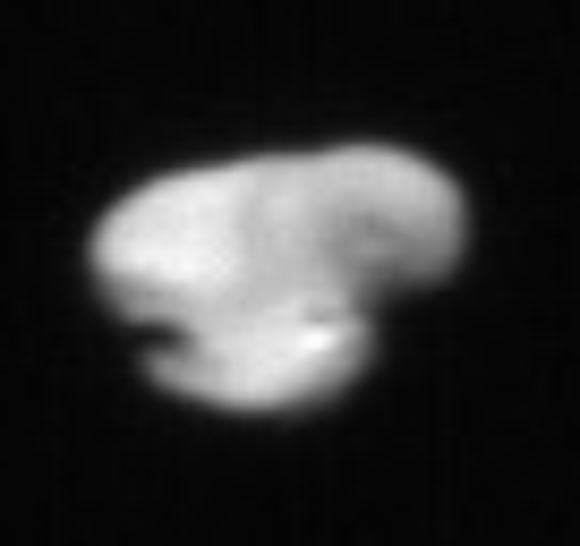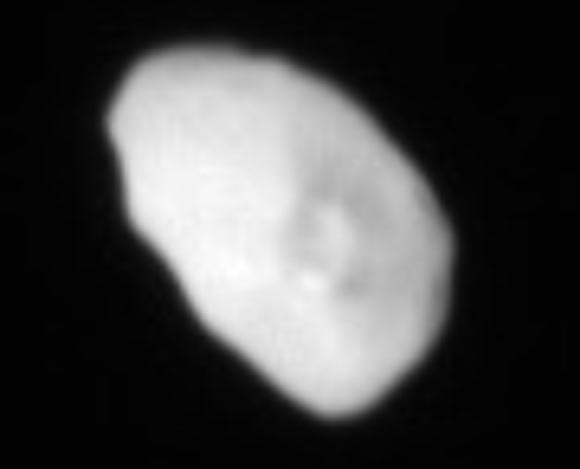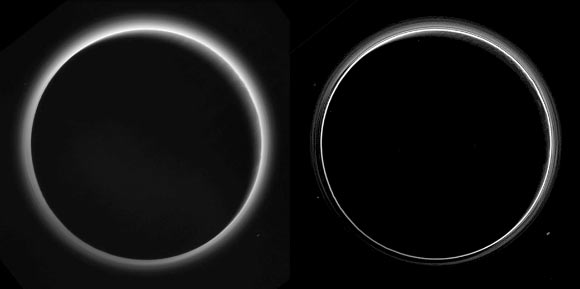NASA’s New Horizons spacecraft has sent back new, better images of Pluto’s largest moon, Charon, and the dwarf planet’s smaller satellites Nix and Hydra.

This image of Charon, taken by New Horizons ten hours before its closest approach to Pluto on July 14, 2015 from a distance of 290,000 miles (470,000 km), is a recently downlinked, much higher quality version of a Charon image released on July 15. The smallest visible features are 2.9 miles (4.6 km) in size. Image credit: NASA / Johns Hopkins University Applied Physics Laboratory / Southwest Research Institute.
The images were taken by the sensitive Long Range Reconnaissance Imager (LORRI) on board New Horizons on July 14, 2015. The views were taken from distances between 480,000 and 124,300 miles (770,000 – 200,000 km).
They reveal that each moon is unique and that Charon’s geological past was a tortured one.
Charon, which is 750 miles (1,200 km) in diameter, displays a surprisingly complex geological history, including tectonic fracturing; relatively smooth, fractured plains in the lower right; several enigmatic mountains surrounded by sunken terrain features on the right side; and heavily cratered regions in the center and upper left portion of the disk.
There are also complex reflectivity patterns on the large moon’s surface, including bright and dark crater rays, and the conspicuous dark north polar region at the top of the image.

This image of Pluto’s small moon Hydra was taken by New Horizons’ LORRI instrument on July 14, 2015, from a distance of 124,300 miles (200,000 km). Image credit: NASA / Johns Hopkins University Applied Physics Laboratory / Southwest Research Institute.
Nix and Hydra are much smaller than Charon and have irregular shapes.
Nix is estimated to be 26 miles (42 km) long and 22 miles (36 km) wide. Hydra is 34 miles (55 km) long and 25 miles (40 km) wide.
New Horizons also captured a new image of Pluto’s night side. The image is much higher quality than the digitally compressed images of Pluto’s haze downlinked and released shortly after the July 14 encounter, and allows many new details to be seen.

This image of Nix was taken by New Horizons’ LORRI instrument on July 14, 2015, from a distance of 124,300 miles (200,000 km). Image credit: NASA / Johns Hopkins University Applied Physics Laboratory / Southwest Research Institute.
“This bonus twilight view is a wonderful gift that Pluto has handed to us,” said New Horizons team member Dr John Spencer, also of the Southwest Research Institute.
“Now we can study geology in terrain that we never expected to see.”
The left version has had only minor processing, while the right version has been specially processed to reveal a large number of discrete haze layers in the atmosphere.
In the left version, faint surface details on the narrow sunlit crescent are seen through the haze in the upper right of Pluto’s disk, and subtle parallel streaks in the haze may be crepuscular rays-shadows cast on the haze by topography such as mountain ranges on Pluto, similar to the rays sometimes seen in the sky after the Sun sets behind mountains on Earth.

Two different versions of an image of Pluto’s haze layers, taken by New Horizons as it looked back at Pluto’s dark side nearly 16 hours after close approach, from a distance of 480,000 miles (770,000 km), at a phase angle of 166 degrees. Pluto’s north is at the top, and the Sun illuminates the dwarf planet from the upper right. Image credit: NASA / Johns Hopkins University Applied Physics Laboratory / Southwest Research Institute.
According to New Horizons scientists, Pluto’s global atmospheric haze has many more layers than they realized.
“The haze actually creates a twilight effect that softly illuminates nightside terrain near sunset, making them visible to the cameras aboard the space probe,” they said.
New Horizons is now 3.07 billion miles (4.94 billion km) from Earth and 46.5 million miles (74.8 million km) beyond Pluto. The spacecraft is healthy and all systems are operating normally.







